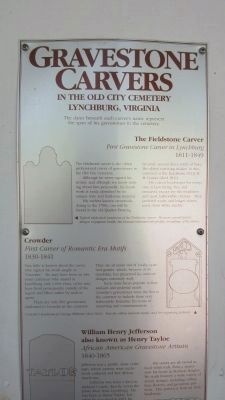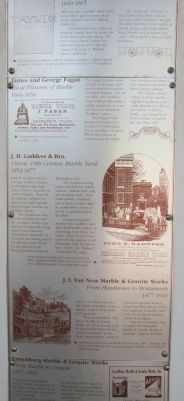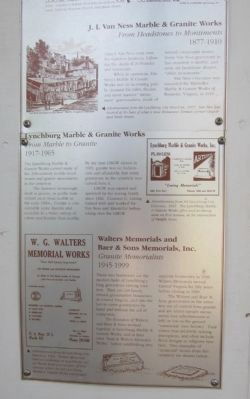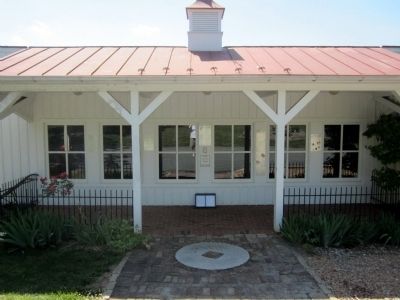Tinbridge Hill in Lynchburg, Virginia — The American South (Mid-Atlantic)
Gravestone Carvers in the Old City Cemetery
The Fieldstone Carver
First Gravestone Carver in Lynchburg
1811-1849
The fieldstone carver is the oldest professional carver of grave stones in the Old City Cemetery.
Although he never signed his stones, and although we know nothing about him personally, his handiwork is easily identified by its unique style and fieldstone material.
His earliest known stonework, dating to the 1790s, can still be found in the old Quaker Burying Ground, several miles south of here. His oldest surviving marker in this cemetery is the headstone of Dr. R.B. Gaines (died 1811).
He carved headstones for everyone in Lynchburg, free and enslaved, except for the wealthiest and most fashionable citizens. They preferred vaults and ledger stones made from white marble.
(caption) Typical triple-arch headstone of the Fieldstone Carver. He never carved artistic designs or popular motifs, but instead elaborated the profile, or outline, of his stones.
Crowder
First Carver of Romantic Era Motifs 1830-1841
Very little is known about the carver who signed his work simply as “Crowder.” He may have been an itinerant craftsman who stayed in Lynchburg only a few years, or he may have lived permanently outside of the region and filled orders by mail or agent.
There are only five gravestones attributed to Crowder in the cemetery. They are all made out of locally quarried granite, which, because of its durability, has preserved his intricate designs extremely well.
Each stone bears popular willow-and-urn and pedestal motifs. Crowder’s gravestones were the first in the cemetery to include these very fashionable Romantic Era icons of mourning and commemoration.
(caption) Crowder’s headstone for George Williams (died 1832). Note the willow and urn motifs, and the supporting pedestal.
William Henry Jefferson also known as Henry Tayloe
African American Gravestone Artisan 1840-1865
Jefferson was a prolific stone craftsman, whose patrons were exclusively enslaved and free African Americans.
Jefferson was born a slave in Amherst County, directly across the James River from Lynchburg. He was born as Henry Tayloe, but when he was freed in 1853, he changed his name to William “Henry” Jefferson.
His stones are all carved in local schist rock, from a quarry near his home in Madison Heights. His work features a wide variety of artistic designs, including coffins, fruit, flowers, and geometric patterns. This pattern is from an 1845 headstone:
(caption) Typical Jefferson headstone, with his signature enlarged. Jefferson signed his stones “H. Tayloe” as late as 1853, before switching to “W.H. Jefferson.”
James and George Fagan
Local Pioneers of Marble
1844-1858
The Fagan brothers were the first local stone craftsmen to popularize marble in Central Virginia. For the first time, area residents could conveniently order a marble tombstone in town, and do so at affordable, “Northern” prices.
The Fagans were natives of Ireland, who worked in Philadelphia, before moving to Virginia. When they arrived in Lynchburg in the 1840s, they brought with them a rich European-American stone cutting tradition.
The Fagans always carved in white marble, and their headstones are easily identified by distinctive willow or flower motifs, and unique headstone profiles, including this one from 1850:
(caption) Advertisement from Edward’s Statistical Gazeteer, 1856.
J. B. Gaddess & Bro.
Classic 19th-Century Marble Yard
1852-1877
John B. Gaddess and his younger brother, Thomas, revolutionized the landscape of every cemetery in Central Virginia. They set the popular standard for gravestones with sophisticated designs and the use of white marble.
The Gaddesses were natives of Baltimore, and the youngest of three generations of nationally recognized stone craftsmen. Their father, Alexander, Sr., is known for carving one of the Masonic stone blocks on the interior of the Washington Monument in Washington, D.C.
The Gaddess iconography included the willow-and-urn, obelisk, bed, rose, and sleeping lamb. Each stone usually combined one or more of these artistic motifs with a verse of poetry or quotation from the Bible.
Gaddess's patrons included the wealthier and more fashionable citizens of Lynchburg, both black and white. Many of their headstones boldly indicate racial distinction, with the inscription, “Col’d,” for “Colored,” carved after the name.
(caption) Advertisement from Edward’s Statistical Gazeteer, 1856. Gaddess’s Marble Yard was located on Ninth Street, halfway between Church and Main Streets.
J. I. Van Ness Marble & Granite Works
From Headstones to Monuments
1877-190
John I. Van Ness took over the Gaddess business, following the death of its founder and namesake.
While in operation, Van Ness’s Marble Granite Works met an increasing public demand for taller, thicker, and more massive “monument” gravemarkers, made of several component stones. Every Van Ness gravestone in this cemetery is marble, and most are headstone shaped, “tablet monuments.”
Van Ness‘s business was succeeded by the Marsteller Marble & Granite Works of Roanoke, Virginia, in 1910.
(caption) Advertisement from the Lynchburg City Directory, 1907. Van Ness was located at the base of what is now Monument Terrace, corner Church and Ninth Streets.
Lynchburg Marble & Granite Works
From Marble to Granite
1917-1965
The Lynchburg Marble & Granite Works carved many of the 20th-century marble headstones and granite monuments in the cemetery.
The business increasingly dealt in granite, as public taste shifted away from marble in the early 1900s. Granite is considerably more durable and available in a wider variety of colors and finishes than marble.
By the time LMGW closed in 1965, granite was so fashionable and affordable that every gravestone in the cemetery was carved from it.
LMGW was owned and operated by the Loving family since 1926. Clarence G. Loving trained with and worked for Van Ness and Marsteller before taking over the LMGW.
(caption) Advertisement from the Lynchburg City Directory, 1931. The Lynchburg Marble & Granite Works office and workshop were on Fort Avenue, at the intersection of Twelfth Street.
Walters Memorials and Baer & Sons Memorials, Inc.
Granite Memorialists
1945-1999
These two businesses are the modern heirs of Lynchburg’s gravestone carving tradition. They are last family owned gravemarker businesses in central Virginia, and also the last to carve gravestones by hand without the aid of computers.
The founders of Walters and Baer & Sons worked together at Lynchburg Marble & Granite Works, and at their own “Baer & Walters Memorial Works,” before establishing two separate businesses in 1949. Walters Memorials served Central Virginia for fifty years for fifty years before closing in 1999.
The Walters and Baer & Sons gravestones in the cemetery are all carved from granite and are either upright monuments (see advertisement at left) or low-to-the-ground “memorials” (see below). Their stones bear relatively sparing inscriptions, and often include floral designs or religious symbols. Two examples of “memorial” stones from this cemetery are shown below:
(caption) Advertisement from the Lynchburg City Directory, 1964. Walters Memorials had two workshops in Lynchburg: one on Wards Road and another off Fort Avenue, where the old Lynchburg Marble & Granite Works was located.
Topics. This historical marker is listed in these topic lists: Cemeteries & Burial Sites • Industry & Commerce. A significant historical year for this entry is 1853.
Location. 37° 24.925′ N, 79° 9.507′ W. Marker is in Lynchburg, Virginia. It is in Tinbridge Hill. Marker can be reached from the intersection of Taylor Street and 4th Street. Touch for map. Marker is at or near this postal address: 401 Taylor Street, Lynchburg VA 24501, United States of America. Touch for directions.
Other nearby markers. At least 8 other markers are within walking distance of this marker. Gravemarkers in the Old City Cemetery (here, next to this marker); Cemetery Caretakers (here, next to this marker); Gravestone Style & Material (a few steps from this marker); African Burial Customs (a few steps from this marker); Julia Whiteley Branch (a few steps from this marker); Julia Whitely Branch Family (a few steps from this marker); Hearse House & Caretakers' Museum (within shouting distance of this marker); Old City Cemetery (within shouting distance of this marker). Touch for a list and map of all markers in Lynchburg.
Also see . . . Hearse House and Caretakers' Museum at the Old City Cemetery. The oldest public cemetery in Virginia still in use today - Central Virginia's most unique public garden. (Submitted on May 30, 2014.)
Credits. This page was last revised on February 1, 2023. It was originally submitted on May 30, 2014, by Bernard Fisher of Richmond, Virginia. This page has been viewed 1,028 times since then and 29 times this year. Photos: 1, 2, 3, 4, 5. submitted on May 30, 2014, by Bernard Fisher of Richmond, Virginia.




